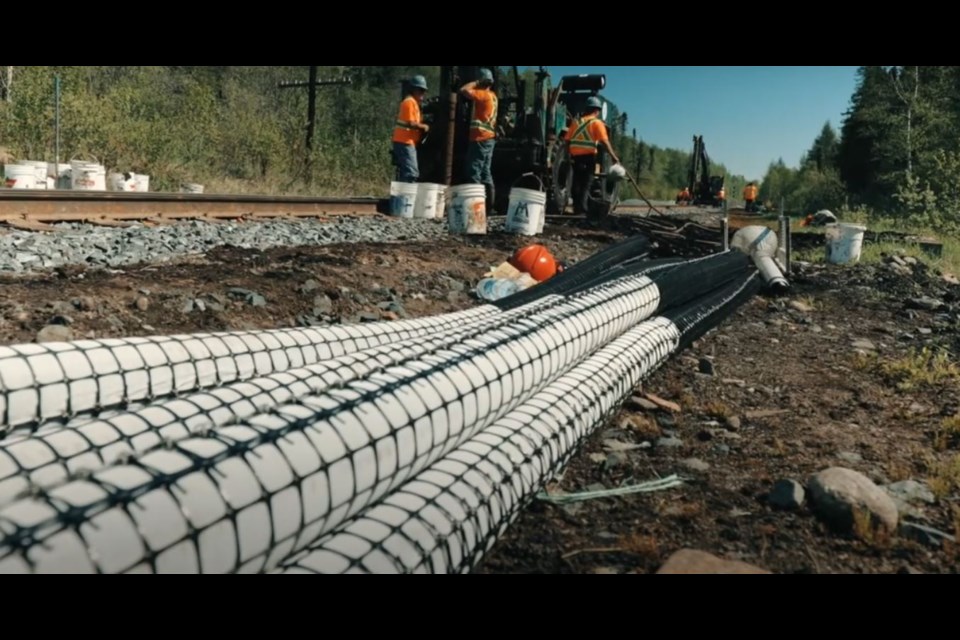THUNDER BAY — A Thunder Bay-developed product that makes railroad beds less likely to become unstable over peat has caught the attention of the North American railway industry.
The Spring Drain or S-Drain, an innovation from TBT Engineering, has received an award from the Railway Engineering-Maintenance Suppliers Association headquartered in Washington, DC.
The event held last week in Louisville, Kentucky was attended by representatives of TBT Engineering and Supercom Industries, a First Nations-owned company that has the exclusive licence for marketing, manufacturing and installation.
"We are incredibly proud to receive the Product Innovation Award," said Sarah Levesque, business development and sales manager for Supercom, headquartered on Fort William First Nation.
"This award validates the hard work and dedication of our team, and it inspires us to continue to increase awareness of our product as we ramp up Spring Drain's commercialization."
TBT Engineering's patented device for improving the stability of railway embankments was launched as a trial with the CPR (now CPKC) in 2015.
Peat can liquefy — a phenomenon known as a peat boil — as increasingly longer and heavier trains pass through wetland areas, resulting in the track being taken out of service for lengthy periods.
"The only way to really fix that at the time was to dig out all the muskeg or the peat and fill it with rockfill. And then a peat boil would show up right adjacent to our fix, because we weren't digging out the whole swamp," said Gord Maki, a vice-president with TBT Engineering and the developer of the S-Drain.
The solution he came up with reduces the risk of liquefied soil being forced upward toward the tracks by pore water pressure.
"If you think of soil as a bunch of particles, in between that is called your pore space. Swamps are full of water, so when the train comes across, it tries to squeeze all the particles together, which increases the pressure of that water to the point where it actually squirts out of the ground like a little volcano," Maki explained.
He said despite the name, the invention is more accurately described as a pressure relief system.
"If a sponge is full of water, and you wrap it in cellophane, then try to squeeze that sponge, you can't because the water is resisting it. If you poke a little hole in the cellophane, you get a bunch of water squirting out. That's basically what this product does.... We poke a lot of holes into that sponge."
The tube-shaped S-Drains are placed vertically in four-metre-long holes drilled between the railway ties, then filled with loose stone.
Made of corrugated weeping tile wrapped in strong, pre-stressed material similar to high-density polyethylene, multiple units installed beneath the tracks facilitate the transfer of a train's load over soft and spongy terrain.
"When that energy goes into that pre-stressed material, it pushes out, then when the load's off again it pulls it back in again nice and tight ... so it acts more like a spring. The spring is the really important part of the thing that makes it work compared with some of the other products out there," Maki said.
S-Drains have been proven to make the ground more stable and sharply reducing the build-up of water pressure via rapid drainage.
"We're getting basically a 95 per cent reduction in pore water pressure when we install these. Even the first ones we put in in 2015, they're working perfectly."
Since then, he said, the company has worked on eight project sites, installing as few as 75 drains to as many as 600, depending on the location.
TBT Engineering's partnership with Supercom was launched in 2023.
Levesque called the Spring Drain a game-changer in the railway industry, crediting it with preventing potential safety hazards while reducing ongoing maintenance costs and operating costs.
"We have the sole licence to market, sell, distribute, install the drain, and that is what we are doing right now. We had to fine-tune a few things. We had to get the manufacturing facility up and running so that once we started getting sales, we had the ability and capacity to build the drains."
The exposure the Spring Drain is receiving because of the award is crucial, she said, because until now the company and the drain have had a fairly low profile.
"This product is very new. So just having that product awareness is really important to us. We know what the capabilities are, and how it's going to help.... Our product is patented for North America. There's a lot of peat specifically in Canada, mostly in Ontario, but there is also quite a lot of peat in swampy areas in the United States."
Levesque said additional manufacturing may be done in the future on other First Nations.
Supercom was originally formed by six Lake Superior-area First Nations in 2016 to maximize employment and economic benefits during the construction of the East-West Tie transmission line between Wawa and Thunder Bay.
— TBnewswatch




